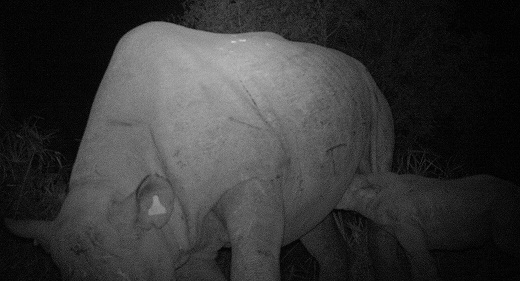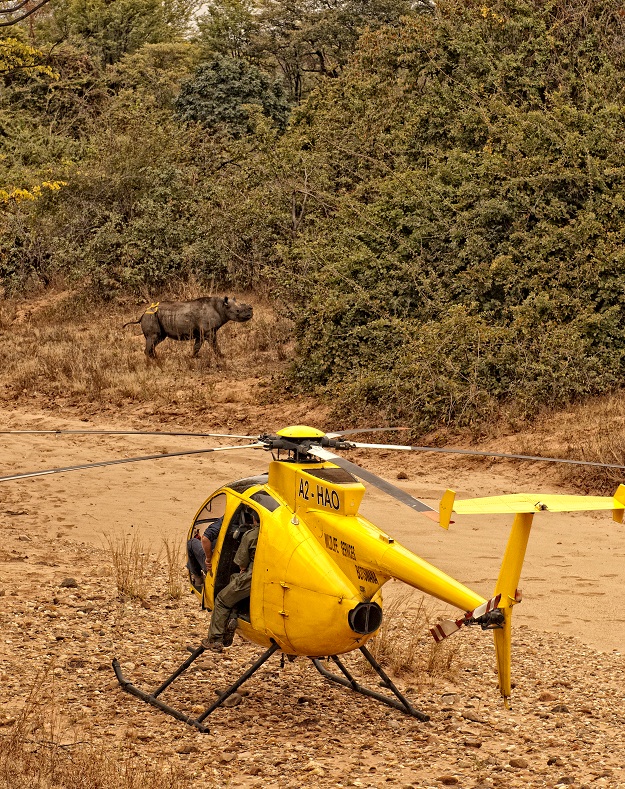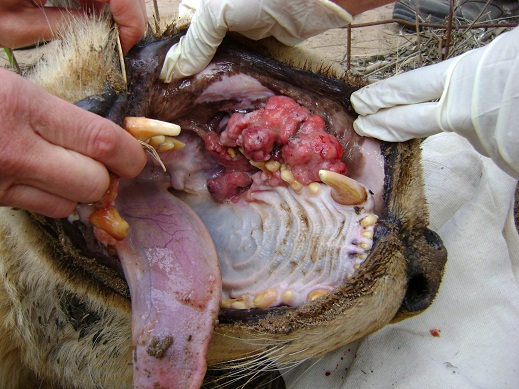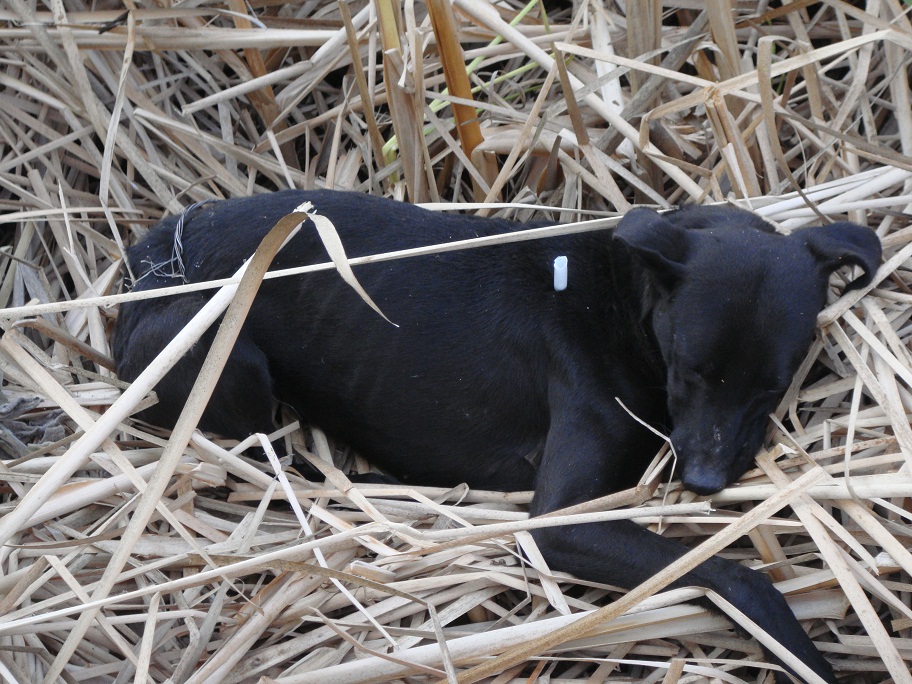|
The private lives of rhino
In June, AWARE initiated an exciting new rhino monitoring exercise using camera traps in a particular National Park in the country (specific details and numbers intentionally omitted for security reasons). The terrain in this park has proved to be ideal for monitoring in this fashion and it is the biggest breakthrough for acquiring positive identification pictures of these rhinos in decades. (Approaching black rhinos to within 30m - the distance required to get good photographs of their ears - is notoriously difficult as they often hide in thick bush and take flight at the slightest sound or smell. They also have notoriously bad tempers!) The camera traps sense movement using infra-red, and are set to take photos every 10 seconds whilst something is moving in front of them. The best thing about them is that the animals are completely undisturbed and picture sequences are giving us a good idea of their social interactions as well as identification.
 The first 6 weeks have yielded more than 25 000 photographs, of which more than 10% documented rhino activity. We have been able to positively identify more than 80% of the rhino in this park from this data. Unfortunately, baboons in the area (whose activities were responsible for about 70% of the pictures) thought the cameras made rather novel toys, and they completely destroyed 2 cameras, damaged another and a fourth camera has gone AWOL. We are soon to acquire baboon proof cages for the cameras. We have very useful photographic evidence of a variety of other species, should bona-fide research projects wish to contact us for this information. The first 6 weeks have yielded more than 25 000 photographs, of which more than 10% documented rhino activity. We have been able to positively identify more than 80% of the rhino in this park from this data. Unfortunately, baboons in the area (whose activities were responsible for about 70% of the pictures) thought the cameras made rather novel toys, and they completely destroyed 2 cameras, damaged another and a fourth camera has gone AWOL. We are soon to acquire baboon proof cages for the cameras. We have very useful photographic evidence of a variety of other species, should bona-fide research projects wish to contact us for this information.
Matusadona rhino management operation
 In early July AWARE teamed up with the Zambezi Society, SAVE and PWMA to undertake a population audit and ear notching and dehorning exercise in Matusadona National Park. The operation, led by AWARE vets, was safely conducted with all the rhino in the area being dehorned. An extensive search operation was performed which left the fixed wing pilot’s 35 hour GPS track log looking like he had scribbled Matusadona off the map in frustration. Sadly, there appear to be far fewer rhino than previously anticipated, a finding corroborated by Pete Clemence’s 3 week ranger training course which started as the dehorning operation finished. Poaching would appear to be a massive problem in the Kariba surrounds, and we have heard of several cases of elephant poaching using poison placed in bread within the last month. In early July AWARE teamed up with the Zambezi Society, SAVE and PWMA to undertake a population audit and ear notching and dehorning exercise in Matusadona National Park. The operation, led by AWARE vets, was safely conducted with all the rhino in the area being dehorned. An extensive search operation was performed which left the fixed wing pilot’s 35 hour GPS track log looking like he had scribbled Matusadona off the map in frustration. Sadly, there appear to be far fewer rhino than previously anticipated, a finding corroborated by Pete Clemence’s 3 week ranger training course which started as the dehorning operation finished. Poaching would appear to be a massive problem in the Kariba surrounds, and we have heard of several cases of elephant poaching using poison placed in bread within the last month.
Update on Masvingo lions
 Last week we were called to the lions in Masvingo to look at one of the lionesses that was ‘not doing well’. She had developed a large malignant tumour on her face, and the decision was taken to euthanase her. Whilst we were on the property we were asked to immobilize 2 lions which the landowner had given permission to be moved to Bally Vaughan Animal Sanctuary, representatives of which were waiting to take the lions. Last week we were called to the lions in Masvingo to look at one of the lionesses that was ‘not doing well’. She had developed a large malignant tumour on her face, and the decision was taken to euthanase her. Whilst we were on the property we were asked to immobilize 2 lions which the landowner had given permission to be moved to Bally Vaughan Animal Sanctuary, representatives of which were waiting to take the lions.
The remaining lions were in very good condition. The contraceptive implants that we administered in January, in addition to making the animals gain some weight, have quelled the competitive aggression related to oestrus in the enclosures, and we did not see any bite or scratch wounds on the animals.
Unfortunately there is still a political impasse over the water installation, despite AWARE having delivered a tank and poly-pipe to the site, and a trench having been dug. VAWZ is looking into this from a legal perspective. In the meantime water is being supplied by bowser. AWARE has had five sliding gates made for the management pans and these are waiting for collection and installation.
On a private veterinary visit to Antelope Park last month we saw the lone juvenile lioness moved from Masvingo in January, now named Mana. She has settled in well with a male and female companion and is in their ‘night hunting’ programme, where they are let out onto the game farm to see if they can prove their hunting ability. We micro-chipped her and tested her for FIV as is standard practice at Antelope Park. We hope she will be destined for a soft release at some stage in the future.
Animal rescues
 AWARE responded to several calls for help for semi-wild dogs in the Harare area. A feral black cross-bred male dog, subsequently named ‘Jet’, who had literally been ‘thrown out’ on the street as he was fighting with the owner’s other dogs, had to be darted to remove a wire snare that had become embedded around his waist. This proved to be a difficult operation as the dog took off after the first dart and disappeared into a vlei and could not be located for over an hour. By the time he was found the drug was already wearing off which necessitated a second dart and a second chase across a busy AWARE responded to several calls for help for semi-wild dogs in the Harare area. A feral black cross-bred male dog, subsequently named ‘Jet’, who had literally been ‘thrown out’ on the street as he was fighting with the owner’s other dogs, had to be darted to remove a wire snare that had become embedded around his waist. This proved to be a difficult operation as the dog took off after the first dart and disappeared into a vlei and could not be located for over an hour. By the time he was found the drug was already wearing off which necessitated a second dart and a second chase across a busy
road. He has since been treated, neutered, and is awaiting re-homing at the Friend Animal Foundation (FAF). FAF also required our services to neuter and move an intractably aggressive dog called Duke into a larger retirement pen. The Harare SPCA called us to euthanase a thoroughly miserable dog that could not be handled and had no hope of re-homing. Mukuvisi Woodlands has also requested our help as a pack of dogs keeps breaking into their park and has allegedly killed 10 impala so far. We have loaned them our dog trap and wait to see if any dogs are caught. We hope that this spirit of co-operation between animal welfare organisations continues.
In another incident, a duiker which had been chased into a Harare home by a stone throwing mob desirous of its meat was immobilized and taken to a game park on the outskirts of Harare.
Rabies alert!
In July, on a private veterinary visit to a park on the outskirts of Harare, we had a rather astonishing case of rabies in a zebra. Having chatted to the rabies lab, we have discovered that rabies is rife in Harare at the moment. Anyone living in Zimbabwe should make sure their dogs, cats, horses and any other mammals they are responsible for are fully vaccinated.
Ranger Training
Pete Clemence’s ranger training courses are progressing well with Basic courses now having been completed in all National Parks’ Intensive Protection Zone areas. Intermediate courses are due to start on Monday 15th August. We firmly believe this will have the most significant impact for conservation in Parks this year. There is still a shortfall of equipment needed and ammunition to be supplied, as well as fuel for logistics. Please help this worthy cause!
Donkey Clinics
Erick’s ambulatory donkey clinics continue with 685 donkeys having received veterinary treatment in six weeks of the last 3 months. We are looking forward to a visit from the funder of these clinics, SPANA, later this month.
Thanks
We continue to rely on the generosity of others to fund and help with our work. In particular we would like to thank:
- SAVE Foundation of Australia
- Zambezi Society
- Ritch Gillam
- Lake Crocodile Farm (Gary Sharpe and Pierre Steyn)
- SPANA
- KDB
- Johnny Rodrigues (ZCTF)
- Hayley Adams (Silent Heroes)
- Andries Scholtz
- Zoe Van Zyl
- Dave Bradshaw
- Charlie Pinkham
- Jan (Avondale Vet)
- Marylu (Friend Foundation)
- Pam Marabini
- Eric (photographer)
- Spar Ballantyne
- Anne Murray
- Our members
|